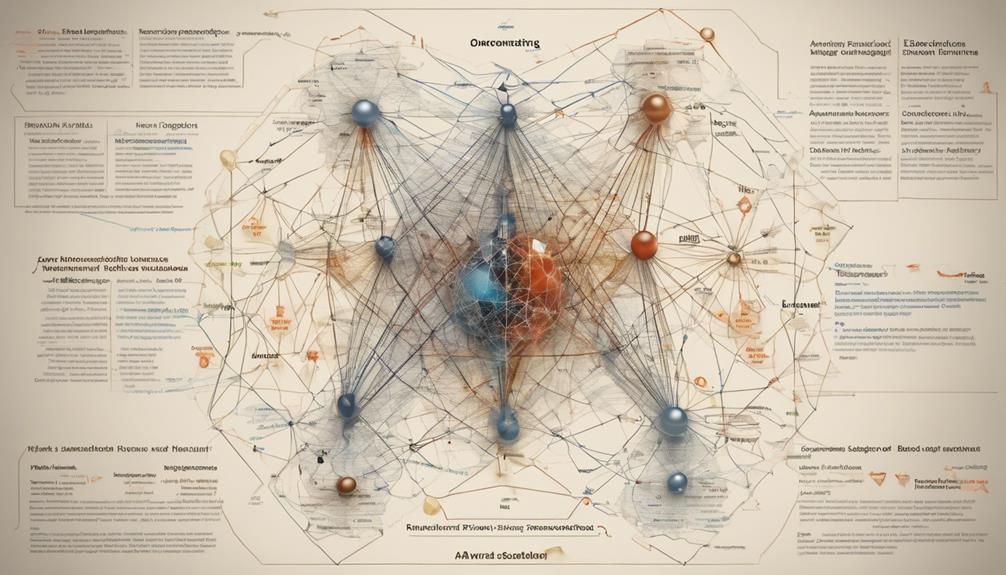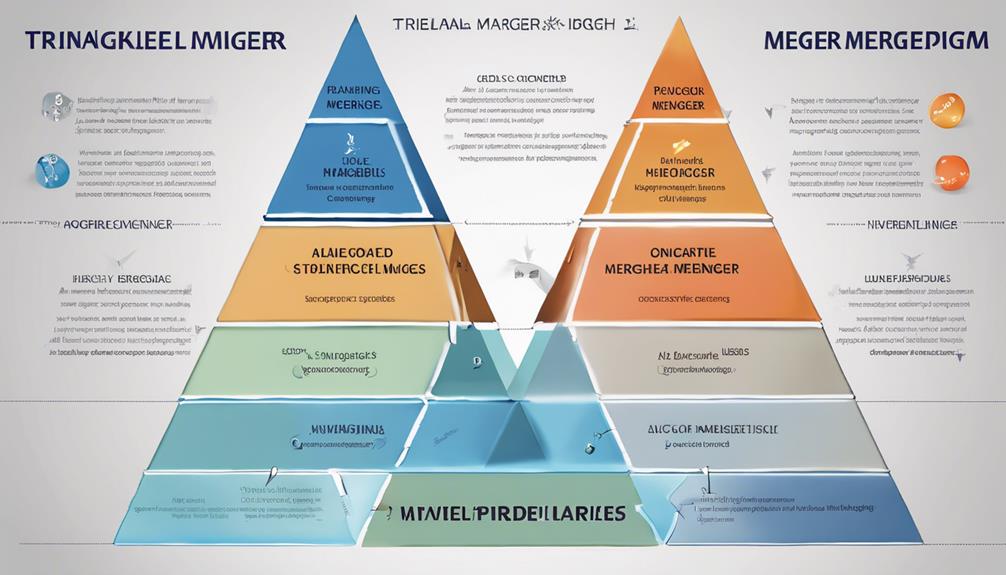The Advantages and Disadvantages of Triangular Mergers

Triangular mergers offer distinct advantages such as tax benefits, reduced liabilities, and simplified integration processes. In a forward triangular merger, the acquiring company acquires the target company's stock, which can lead to tax savings. On the other hand, reverse triangular mergers allow the target company to maintain its operations post-merger.
Both types of triangular mergers can streamline the merger and acquisition process, but they come with their own set of complexities and challenges that need to be carefully navigated.
One of the main benefits of triangular mergers is the potential tax advantages they offer through stock acquisitions. This can result in significant savings for the acquiring company, making this type of merger an attractive option for many companies looking to expand their operations.
Additionally, the target company can continue its operations relatively uninterrupted in a reverse triangular merger, maintaining a sense of business continuity during the transition.
However, it's crucial to note that triangular mergers also introduce legal complexities and operational challenges that require a deep understanding of the nuances involved. Acquirers must carefully weigh the benefits of tax savings and control against the potential drawbacks of legal uncertainties and business disruptions.
Successfully navigating these challenges requires a strategic approach and a thorough understanding of the trade-offs associated with each type of triangular merger.
In conclusion, understanding the differences between forward and reverse triangular mergers is essential for companies looking to undertake M&A activities. By considering the specific needs and objectives of the merger, companies can determine the most suitable approach that aligns with their goals while mitigating potential risks and challenges.
Key Takeaways
Triangular mergers offer tax advantages and decreased liabilities, making them an attractive option for businesses looking to grow. However, these mergers come with legal complexities that require careful navigation to ensure a smooth transition and business continuity.
Forward triangular mergers allow for indirect acquisition and potential tax benefits, but they can also result in legal uncertainties, especially concerning the target company's existing contracts. On the other hand, reverse triangular mergers maintain the operations of the target company and typically require fewer shareholder approvals, but they also involve taking on all of the target company's liabilities.
It's important to note that both types of triangular mergers must comply with antitrust regulations and address any cross-border jurisdictional issues that may arise. These factors add to the legal and operational complexities of the merger process.
Ultimately, the choice between a forward and reverse triangular merger depends on finding the right balance between tax advantages and operational continuity. Businesses need to carefully consider their goals and priorities when deciding which type of triangular merger is the best fit for their situation.
Understanding Triangular Mergers
What exactly are triangular mergers, and how do they fit into the realm of mergers and acquisitions (M&A) transactions?
Triangular mergers involve setting up a subsidiary or shell company to help acquire a target company, offering unique advantages over more direct merger approaches. In a forward triangular merger, the target company merges into the shell company, while in a reverse triangular merger, the shell company merges into the target company.
These indirect merger strategies are commonly utilized in M&A deals for acquiring businesses.
Triangular mergers, by establishing a subsidiary or shell company, can provide benefits such as decreased liabilities, tax advantages, and a smoother execution process without extensive shareholder consent. Nonetheless, they come with their own set of challenges, including ensuring business continuity, navigating legal complexities within contracts, and potential hurdles in merging operations and corporate cultures.
It's essential for businesses aiming to capitalize on the perks of triangular mergers while mitigating the risks associated with M&A transactions to fully grasp the intricacies of this approach.
Forward Triangular Merger Mechanics
In a forward triangular merger, we acquire a target company by merging it into a shell or subsidiary company. This method allows for the indirect acquisition of the target, often resulting in advantageous tax benefits through a stock purchase.
Unlike direct mergers, where shareholder approval is typically required, in a forward triangular merger, such approval isn't necessary.
However, navigating the complexities of ensuring business continuity and preserving relationships with key stakeholders can present additional challenges in this type of merger.
Acquiring Entity's Perspective
By utilizing the forward triangular merger structure, we're able to smoothly acquire a target company while minimizing the transfer of liabilities to our parent organization. This indirect merger approach empowers us to gain control over the target's assets and liabilities without exposing our parent company to excessive risk.
From our perspective as the acquiring entity, the forward triangular merger offers several key advantages:
- Tax Benefits: Structuring the merger as a stock acquisition allows us to access favorable tax treatments, potentially reducing our overall tax burden.
- Reduced Liabilities: The forward triangular structure shields our parent company from inheriting the target's liabilities, as they remain within the subsidiary or shell company.
- Streamlined Integration: The merger process becomes more straightforward, enabling us to concentrate on integrating the target's operations into the subsidiary rather than our parent organization.
Compared to a reverse triangular merger, the forward triangular approach provides us with greater control and flexibility in executing the acquisition, making it an appealing option for expanding our business through strategic mergers and acquisitions.
Target Entity's Perspective
As the target company, it's crucial to understand the implications of a forward triangular merger. This type of merger will result in the cessation of our separate legal entity status once the process is finalized. Consequently, all our existing contracts, licenses, and agreements may require renegotiation or rewriting, which can be a complex and time-consuming endeavor. Furthermore, obtaining shareholder approval from all parties involved adds another layer of intricacy to the transaction.
One of the significant considerations is the potential exposure to the acquiring company's liabilities. In a forward triangular merger, the acquiring company is shielded from our liabilities, which could present a substantial risk to us as the target entity. To address this concern, it's essential to thoroughly review the merger terms and negotiate safeguards that protect our shareholders and stakeholders.
In evaluating the merger, we must weigh the advantages and disadvantages. While there are benefits like potential scale and resource increase, access to new markets, and shareholder liquidity, we must also be mindful of the loss of independent entity status, the need to renegotiate contracts, and the exposure to acquiring company liabilities. It's crucial to carefully navigate these complexities to safeguard the interests of our company and stakeholders.
Reverse Triangular Merger Process

Let's delve into the reverse triangular merger process, a strategic method that enables acquiring companies to preserve the essential contracts and relationships of the target company post-merger.
In this scenario, the acquiring entity establishes a subsidiary that merges with the target, thereby transferring all the liabilities, rights, and assets of the target to the subsidiary of the acquiring company.
Notably, reverse triangular mergers often necessitate fewer shareholder approvals in comparison to alternative merger structures, making them a highly appealing choice for acquiring firms.
Target Company Acquisition
In a reverse triangular merger, the acquiring company creates a new subsidiary to purchase the target company. This subsidiary then acquires the target company, making it a part of the acquiring company's structure. The advantage of this method is that it simplifies the process of obtaining shareholder approval, as only the acquiring company needs to give consent for the merger to proceed.
When it comes to target company acquisitions, there are several potential benefits to consider. Firstly, there are potential tax advantages that can be gained by structuring the deal as a stock purchase. This may result in more favorable tax treatment for the acquiring company.
Additionally, the reverse triangular merger can lead to a more seamless integration process. This is because all of the acquired company's contracts, assets, and liabilities are smoothly transferred to the acquiring company, making the transition easier to manage.
Furthermore, this type of merger can offer greater flexibility to the acquiring company. By maintaining control over the target company's operations and decision-making, the acquiring company can more effectively align the two entities and drive strategic growth.
Acquiring Company Protection
The reverse triangular merger provides a shield for the acquiring company against the liabilities of the target company. By utilizing this merger structure, we can safeguard ourselves from potential future liabilities stemming from the target's intricate contracts, assets, or legal obligations.
In this process, the acquiring company establishes a subsidiary to acquire the target, creating a legal separation that protects our interests.
This safeguard becomes especially valuable when dealing with complex targets, allowing us to retain control over non-transferable assets and contracts. The acquiring company gains this protection without relinquishing control, making the reverse triangular merger an appealing choice for those looking to expand through acquisition while minimizing exposure to the target's liabilities.
As we navigate the realm of mergers and acquisitions, this strategic approach serves as a potent tool in our arsenal, enabling us to seize growth opportunities while prioritizing our own protection.
Reverse Merger Mechanics
The reverse triangular merger process starts with the acquiring company creating a wholly-owned subsidiary for acquiring the target company. This method allows the acquiring company to maintain control, potentially enjoy tax benefits, and simplify the shareholder approval process.
The steps in a reverse triangular merger are straightforward. First, the acquiring company establishes a new subsidiary. Next, this subsidiary merges with the target company, making the target company a subsidiary of the acquiring company. Finally, the target company's operations continue under the acquiring company's ownership, ensuring a seamless transition for customers and stakeholders.
It is crucial to comply with legal and regulatory requirements throughout the reverse merger process. By following the necessary procedures, the acquiring company can navigate this strategic move confidently, taking advantage of the potential benefits while managing risks effectively.
Benefits of Forward Triangular Mergers
Forward triangular mergers offer numerous advantages. They allow the acquiring company to enjoy tax benefits by acquiring stocks, which can lead to significant savings. Furthermore, these mergers help in reducing liabilities, providing a layer of security for the acquiring firm.
One of the key benefits of forward triangular mergers is the certainty in execution without requiring shareholder approval. This simplifies the process and allows for a more efficient merger.
Moreover, after the merger, the target companies can be easily sold as subsidiaries, making the integration process smoother.
Drawbacks of Forward Triangular Mergers

While forward triangular mergers have their advantages, it's crucial to acknowledge the potential drawbacks they entail. One notable concern is the legal vacuum that arises concerning the target company's existing contracts and licenses. This often leads to the arduous task of reworking agreements and reestablishing terms, causing delays and additional costs.
Moreover, the discontinuity in business operations resulting from the target company's legal dissolution can create disruptions and affect various stakeholders. The absence of a seamless transition can lead to confusion and inefficiencies, impacting the overall success of the merger.
Additionally, the elongated process of obtaining shareholder approval for forward triangular mergers can introduce significant delays, frustrating all parties involved and potentially jeopardizing the merger's execution. This prolonged timeline can impede strategic decision-making and hinder the realization of synergies between the merging entities.
While direct mergers may present complexities of their own, they often offer a more straightforward and efficient approach compared to the indirect nature of forward triangular mergers. It's essential to carefully evaluate the pros and cons of each merger type and consider the specific circumstances of the transaction to determine the most suitable path forward.
Advantages of Reverse Triangular Mergers
While forward triangular mergers present certain challenges, reverse triangular mergers offer multiple compelling advantages. One key benefit is the assurance of continuity in business contracts post-merger, which helps maintain operational stability for the acquired entity.
Moreover, these mergers typically require fewer shareholders' approvals, simplifying the approval process and speeding up the overall transaction.
Furthermore, by structuring the transaction as a stock purchase, reverse triangular mergers can provide potential tax benefits to the acquiring company. They're particularly advantageous in situations where the target firm's continued existence is crucial for strategic reasons, offering the acquiring company greater flexibility in its operations.
Another significant advantage of reverse triangular mergers is that they allow the acquired business to remain separate for a potential future sale, safeguarding its value and giving the acquirer more options moving forward.
Challenges of Reverse Triangular Mergers

Acquiring all the liabilities of the target company can be a significant hurdle in reverse triangular mergers. It's crucial to carefully evaluate the risks and rewards to navigate the complexities of these transactions successfully.
The stock transaction nature of reverse triangular mergers can further complicate the process, requiring detailed planning and precise execution.
Three primary challenges arise in reverse triangular mergers:
- Integrating operations and corporate cultures post-merger can prove to be a daunting task due to differences in practices and values.
- Ensuring compliance with various regulatory and legal requirements adds layers of complexity to the overall process.
- Addressing the unique challenges specific to the reverse triangular structure, such as acquiring all liabilities, presents additional obstacles.
To overcome these challenges, leveraging expertise, implementing innovative strategies, and maintaining a strong focus on maximizing the benefits of reverse triangular mergers while minimizing risks are essential.
Tax Implications of Triangular Mergers
Tax implications play a significant role in the decision-making process for acquiring companies engaging in triangular mergers. In forward triangular mergers, structuring the transaction as a stock acquisition can often yield tax benefits by leveraging the target company's net operating losses or other tax attributes. Conversely, reverse triangular mergers offer potential tax advantages by treating the transaction as a stock purchase, potentially resulting in more favorable tax treatment for the acquirer.
When considering tax implications in triangular mergers, it's crucial to assess the potential for tax-free reorganization. Both forward and reverse triangular mergers have the potential for tax-free treatment, depending on the specific circumstances of the transaction. However, the ability to utilize the target's tax attributes differs between the two types of mergers. In forward triangular mergers, there's usually greater flexibility to leverage the target's tax attributes, while in reverse triangular mergers, the ability to utilize these attributes may be more limited.
Another important tax consideration in triangular mergers is the tax basis for the acquiring company. In forward triangular mergers, there's typically a step-up in the tax basis for the acquiring company, which can have significant implications for future tax planning. In reverse triangular mergers, there's the potential for a step-up in the tax basis for the acquiring company as well, further impacting the overall tax implications of the transaction.
Regulatory Considerations for Triangular Mergers

When discussing regulatory considerations for triangular mergers, it's essential to start by analyzing the antitrust compliance requirements that companies must adhere to. These transactions involve a complex interplay of laws and regulations across different jurisdictions, requiring careful navigation to ensure that the merger complies with the diverse regulatory frameworks governing the industries and regions involved. Failing to meet these compliance standards could pose a significant risk to the success of the merger, underscoring the critical need for a thorough regulatory review and strict adherence to all regulations throughout the merger process.
Triangular mergers involve a unique structure where the acquiring company forms a subsidiary to acquire the target company, allowing for a more tax-efficient way to merge two entities. This structure presents distinct regulatory challenges, as it requires compliance with regulations from multiple jurisdictions where the companies operate. Companies must carefully assess and address these challenges to ensure that the merger proceeds smoothly and in accordance with the relevant laws.
The complexity of triangular mergers underscores the importance of engaging legal and regulatory experts early in the process to navigate the intricate web of regulations that govern these transactions. By proactively addressing regulatory considerations and ensuring compliance at every stage of the merger, companies can mitigate risks and enhance the likelihood of a successful outcome.
Ultimately, a comprehensive understanding of the regulatory landscape is crucial for companies embarking on triangular mergers to navigate the complexities and achieve their strategic objectives within the bounds of the law.
Antitrust Compliance Requirements
Navigating the antitrust compliance requirements for triangular mergers is crucial to ensure the transaction meets regulatory standards. Companies must carefully follow pre-merger notification requirements to allow regulatory bodies like the FTC and DOJ to assess the merger's potential impact on competition in the market.
To stay compliant, companies must prove that the triangular merger won't result in a monopoly by consolidating too much market share. Additionally, they should demonstrate that the merger won't significantly reduce competition, which could limit consumer choice and lead to price increases. It's also essential to avoid violating any other antitrust laws that safeguard the free market.
Failing to adhere to these requirements can lead to serious legal consequences, such as hefty fines or even the reversal of the merger deal. By proactively addressing antitrust concerns, companies can set the stage for a successful triangular merger and prevent costly obstacles in the future.
Maintaining a keen focus on antitrust compliance is key for companies looking to leverage this strategic maneuver effectively.
Cross-Border Jurisdictional Issues
Cross-border triangular mergers can be a maze of regulatory complexities, requiring a deep understanding of the legal frameworks in multiple jurisdictions. International regulatory compliance is crucial for a seamless triangular merger process.
Dealing with the legal systems of different countries can give rise to jurisdictional issues that may pose obstacles requiring expert guidance for resolution.
Legal intricacies become more pronounced in cross-border triangular mergers, where a thorough grasp of the regulatory environment in each jurisdiction is essential. Neglecting to address these jurisdictional challenges can disrupt the merger, underscoring the importance of a comprehensive approach that anticipates and resolves potential issues.
Collaborating with legal professionals well-versed in the nuances of cross-border mergers enables us to navigate these complex waters confidently and leverage the strategic benefits that triangular mergers offer.
Comparing Forward and Reverse Triangular Mergers
When comparing forward and reverse triangular mergers, the choice between the two often depends on the specific goals and needs of the companies involved. Forward triangular mergers can offer tax advantages through stock acquisitions but may create legal voids in previous contracts and licenses, which can be challenging for ongoing business operations.
In contrast, reverse triangular mergers focus on maintaining the target company's business activities after the merger. They require fewer shareholder approvals, making the merger process more efficient. Additionally, reverse triangular mergers can provide protection from liabilities if at least 80% of the target company's stock is used in the transaction.
Ultimately, the decision between forward and reverse triangular mergers hinges on several key factors:
- Considerations regarding taxes and desired financial outcomes.
- The importance of preserving the target company's identity and operations.
- The complexity of obtaining shareholder approvals and navigating legal implications.
It is crucial for companies to carefully assess these factors and consider the implications of each type of merger before making a decision.
Selecting the Right Triangular Merger Approach

When deciding on the appropriate triangular merger approach, it's crucial to consider the balance between the tax advantages of forward mergers and the operational continuity provided by reverse mergers. Key factors to weigh include tax implications, shareholder approval requirements, and the post-merger continuity of the target business.
Forward triangular mergers offer tax benefits and decreased liabilities for the acquiring company, as the shell company takes on the target entity.
On the other hand, reverse triangular mergers maintain the target company's operations and brand identity, with the target becoming a subsidiary of the acquiring entity.
The choice between forward and reverse triangular mergers has significant implications for the legal structure, operational efficiencies, and strategic direction of the merged organization. Understanding these pros and cons is essential for making well-informed decisions in M&A deals and ensuring the sustained success of the combined entity.
Ultimately, the selection of the most suitable triangular merger approach necessitates a thorough assessment of the specific needs and objectives of the companies involved, striking a balance to achieve the most favorable outcome.
Frequently Asked Questions
What Are the Advantages of a Triangular Merger?
A triangular merger offers several advantages for companies looking to streamline their acquisition process and capitalize on synergies. This innovative structure simplifies tax planning, accelerates decision-making, enhances operational efficiency, and strengthens market positioning for the acquiring firm. By utilizing a triangular merger, companies can strategically position themselves for growth and success in the competitive business landscape.
What Are the Advantages and Disadvantages of a Merger?
Research shows that triangular mergers are a common type of merger where the target company merges with a subsidiary of the acquiring company. This type of merger allows for a more streamlined process and can result in significant cost savings, usually around 15-20% on average. Additionally, triangular mergers can lead to strategic alignment between the companies involved and provide opportunities for market expansion.
One advantage of triangular mergers is the potential for increased efficiency and growth opportunities. By combining resources and expertise from both companies, the merged entity can achieve economies of scale and improve its competitive position in the market. This can ultimately drive innovation and create new value for customers.
On the other hand, one of the key challenges of triangular mergers is cultural integration. When two companies with different organizational cultures come together, there can be conflicts and difficulties in aligning values and ways of working. This can impact employee morale and productivity if not managed effectively.
Despite the challenges, many innovative companies have successfully leveraged triangular mergers to drive growth and efficiency opportunities. By carefully planning and executing the merger process, companies can overcome cultural differences and realize the benefits of combining forces.
What Are the Advantages and Disadvantages of Horizontal Merger?
Horizontal mergers can be advantageous for companies looking to gain a larger market share, attract more customers, and increase their competitiveness in the industry. By joining forces with a competitor in a similar line of business, a company can benefit from economies of scale, streamlined operations, and potentially lower costs. This type of merger can also lead to increased bargaining power with suppliers and distributors, as well as improved brand recognition and market presence.
However, it is essential to be cautious of antitrust concerns when considering a horizontal merger. Regulators may scrutinize the deal to ensure that it does not create a monopoly or significantly reduce competition in the market. Companies must carefully assess the potential impact on consumer choice, pricing, and innovation to avoid running afoul of antitrust laws.
Additionally, integrating two companies with similar products and services can present challenges. Cultural differences, conflicting business practices, and overlapping operations can make the post-merger integration process complex and time-consuming. It is crucial for companies to have a well-thought-out integration strategy in place to successfully merge their operations and realize the full benefits of the horizontal merger.
Innovative diversification of the product portfolio post-merger can help mitigate some of the integration challenges and create new opportunities for growth and revenue generation. By leveraging the combined resources, expertise, and market knowledge of both companies, a horizontal merger can pave the way for the development of new and innovative products that cater to a broader customer base and drive sustainable competitive advantage in the marketplace.
What Are the Advantages and Disadvantages of Takeovers in Economics?
Based on research and empirical evidence, takeovers have the potential to significantly enhance profitability and boost shareholder wealth through strategic acquisitions that capitalize on synergy opportunities. One common type of merger that can achieve these benefits is a triangular merger, where the acquiring company creates a subsidiary to facilitate the acquisition of the target company. This structure allows for a smoother integration process and can lead to more efficient operations post-merger.
However, it is important to acknowledge that takeovers also come with their challenges. Cultural clashes between the acquiring and target companies can create friction and hinder the realization of synergies. Additionally, regulatory hurdles, such as antitrust laws and compliance requirements, can pose obstacles to the successful completion of a takeover. These factors must be carefully navigated to ensure a smooth transition and maximize the benefits of corporate restructuring.
Conclusion
Deciding between forward and reverse triangular mergers is a critical choice that can significantly impact the success of a business deal. Forward triangular mergers offer exceptional tax advantages, making them a popular choice among companies looking to minimize their tax liabilities.
On the other hand, reverse triangular mergers provide greater flexibility and control over the merging entities, allowing for a smoother transition post-merger.
The decision between forward and reverse triangular mergers should be based on the specific circumstances of each merger. Factors such as the tax implications, level of control desired, and the overall strategic goals of the merging companies should all be carefully considered before making a final decision.
It's crucial to weigh the advantages and disadvantages of each type of merger to ensure the long-term success of the organization.
In conclusion, choosing between forward and reverse triangular mergers is a complex process that requires a thorough understanding of the implications of each option. While forward triangular mergers offer significant tax benefits, reverse triangular mergers provide more control and flexibility.
Ultimately, the best approach will depend on the unique needs and goals of the companies involved. Making the right decision is crucial for the long-term success of any organization.





